Case Study: Integrated Library System and Business Analysis
VerifiedAdded on 2020/02/24
|14
|3807
|132
Case Study
AI Summary
This case study examines an Integrated Library System (ILS), a vital automated system encompassing modules like acquisitions, cataloging, and circulation. The analysis focuses on six core knowledge areas of business analysis: planning and monitoring, elicitation and collaboration, requirements lifecycle management, strategy analysis, requirements analysis, and solution evaluation. The study emphasizes the importance of planning, communication, and adaptability in business analysis, highlighting the need for effective tools and techniques. It delves into how elicitation and collaboration are crucial, especially with the growth of remote work, and how they can be facilitated through computer-supported cooperative systems. Requirements lifecycle management is discussed in terms of ensuring system functionality and long-term performance. Strategic analysis is also addressed, emphasizing the importance of infrastructure for library services, communication of goals, and alignment of planning with budgeting. The case study underscores the need for strategic planning that considers the size and diversity of the library system, providing a structured approach to organizing and coordinating the work of leaders in planning and analysis.
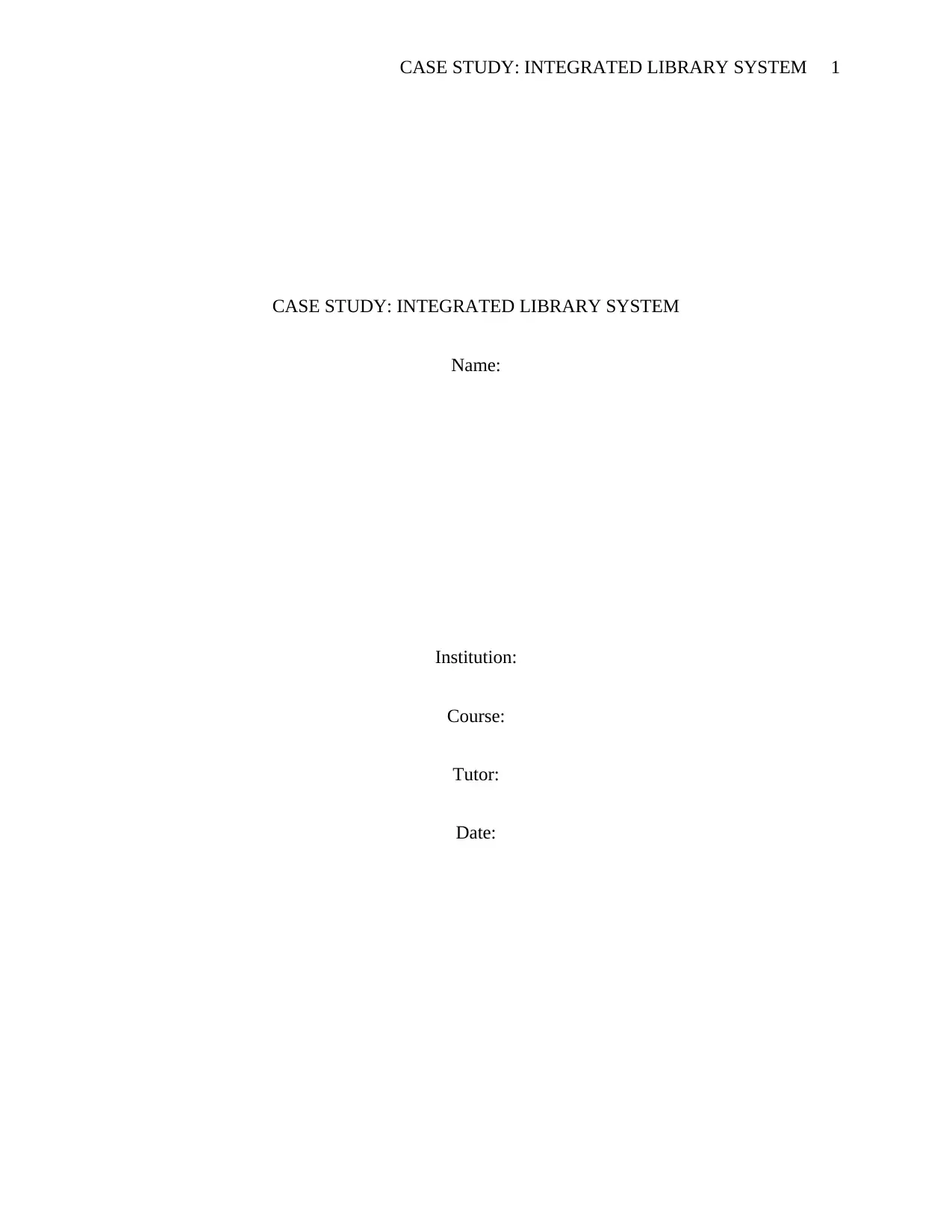
CASE STUDY: INTEGRATED LIBRARY SYSTEM 1
CASE STUDY: INTEGRATED LIBRARY SYSTEM
Name:
Institution:
Course:
Tutor:
Date:
CASE STUDY: INTEGRATED LIBRARY SYSTEM
Name:
Institution:
Course:
Tutor:
Date:
Paraphrase This Document
Need a fresh take? Get an instant paraphrase of this document with our AI Paraphraser
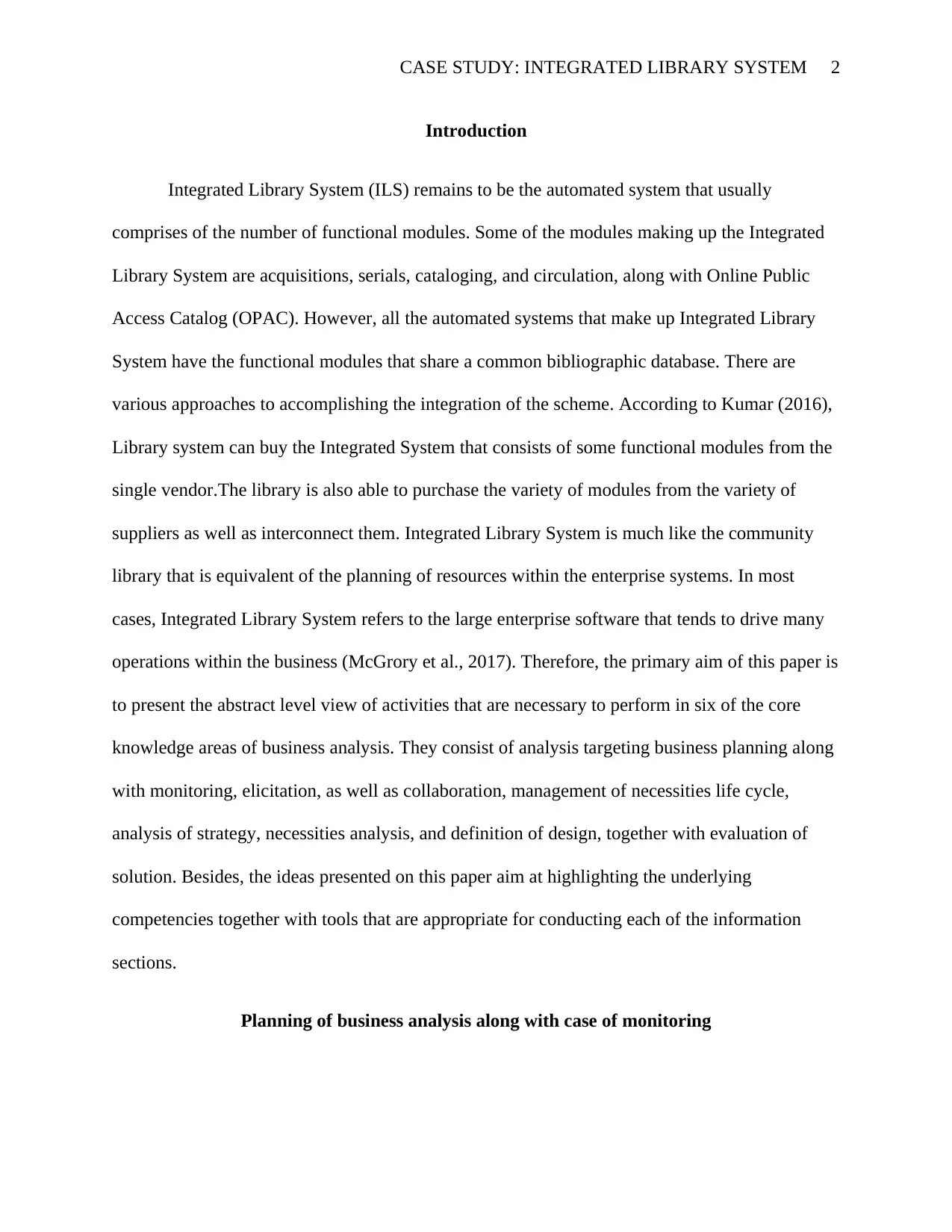
CASE STUDY: INTEGRATED LIBRARY SYSTEM 2
Introduction
Integrated Library System (ILS) remains to be the automated system that usually
comprises of the number of functional modules. Some of the modules making up the Integrated
Library System are acquisitions, serials, cataloging, and circulation, along with Online Public
Access Catalog (OPAC). However, all the automated systems that make up Integrated Library
System have the functional modules that share a common bibliographic database. There are
various approaches to accomplishing the integration of the scheme. According to Kumar (2016),
Library system can buy the Integrated System that consists of some functional modules from the
single vendor.The library is also able to purchase the variety of modules from the variety of
suppliers as well as interconnect them. Integrated Library System is much like the community
library that is equivalent of the planning of resources within the enterprise systems. In most
cases, Integrated Library System refers to the large enterprise software that tends to drive many
operations within the business (McGrory et al., 2017). Therefore, the primary aim of this paper is
to present the abstract level view of activities that are necessary to perform in six of the core
knowledge areas of business analysis. They consist of analysis targeting business planning along
with monitoring, elicitation, as well as collaboration, management of necessities life cycle,
analysis of strategy, necessities analysis, and definition of design, together with evaluation of
solution. Besides, the ideas presented on this paper aim at highlighting the underlying
competencies together with tools that are appropriate for conducting each of the information
sections.
Planning of business analysis along with case of monitoring
Introduction
Integrated Library System (ILS) remains to be the automated system that usually
comprises of the number of functional modules. Some of the modules making up the Integrated
Library System are acquisitions, serials, cataloging, and circulation, along with Online Public
Access Catalog (OPAC). However, all the automated systems that make up Integrated Library
System have the functional modules that share a common bibliographic database. There are
various approaches to accomplishing the integration of the scheme. According to Kumar (2016),
Library system can buy the Integrated System that consists of some functional modules from the
single vendor.The library is also able to purchase the variety of modules from the variety of
suppliers as well as interconnect them. Integrated Library System is much like the community
library that is equivalent of the planning of resources within the enterprise systems. In most
cases, Integrated Library System refers to the large enterprise software that tends to drive many
operations within the business (McGrory et al., 2017). Therefore, the primary aim of this paper is
to present the abstract level view of activities that are necessary to perform in six of the core
knowledge areas of business analysis. They consist of analysis targeting business planning along
with monitoring, elicitation, as well as collaboration, management of necessities life cycle,
analysis of strategy, necessities analysis, and definition of design, together with evaluation of
solution. Besides, the ideas presented on this paper aim at highlighting the underlying
competencies together with tools that are appropriate for conducting each of the information
sections.
Planning of business analysis along with case of monitoring
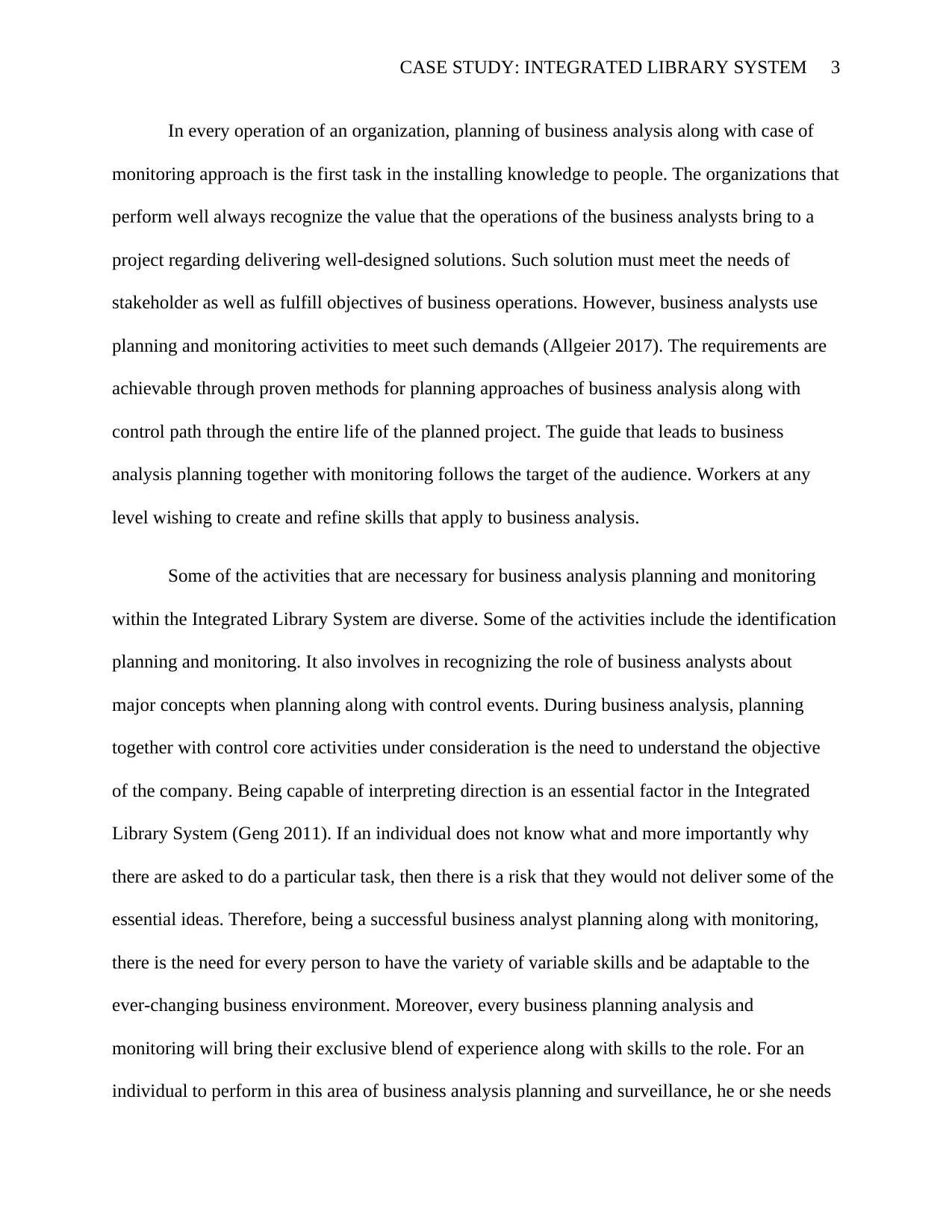
CASE STUDY: INTEGRATED LIBRARY SYSTEM 3
In every operation of an organization, planning of business analysis along with case of
monitoring approach is the first task in the installing knowledge to people. The organizations that
perform well always recognize the value that the operations of the business analysts bring to a
project regarding delivering well-designed solutions. Such solution must meet the needs of
stakeholder as well as fulfill objectives of business operations. However, business analysts use
planning and monitoring activities to meet such demands (Allgeier 2017). The requirements are
achievable through proven methods for planning approaches of business analysis along with
control path through the entire life of the planned project. The guide that leads to business
analysis planning together with monitoring follows the target of the audience. Workers at any
level wishing to create and refine skills that apply to business analysis.
Some of the activities that are necessary for business analysis planning and monitoring
within the Integrated Library System are diverse. Some of the activities include the identification
planning and monitoring. It also involves in recognizing the role of business analysts about
major concepts when planning along with control events. During business analysis, planning
together with control core activities under consideration is the need to understand the objective
of the company. Being capable of interpreting direction is an essential factor in the Integrated
Library System (Geng 2011). If an individual does not know what and more importantly why
there are asked to do a particular task, then there is a risk that they would not deliver some of the
essential ideas. Therefore, being a successful business analyst planning along with monitoring,
there is the need for every person to have the variety of variable skills and be adaptable to the
ever-changing business environment. Moreover, every business planning analysis and
monitoring will bring their exclusive blend of experience along with skills to the role. For an
individual to perform in this area of business analysis planning and surveillance, he or she needs
In every operation of an organization, planning of business analysis along with case of
monitoring approach is the first task in the installing knowledge to people. The organizations that
perform well always recognize the value that the operations of the business analysts bring to a
project regarding delivering well-designed solutions. Such solution must meet the needs of
stakeholder as well as fulfill objectives of business operations. However, business analysts use
planning and monitoring activities to meet such demands (Allgeier 2017). The requirements are
achievable through proven methods for planning approaches of business analysis along with
control path through the entire life of the planned project. The guide that leads to business
analysis planning together with monitoring follows the target of the audience. Workers at any
level wishing to create and refine skills that apply to business analysis.
Some of the activities that are necessary for business analysis planning and monitoring
within the Integrated Library System are diverse. Some of the activities include the identification
planning and monitoring. It also involves in recognizing the role of business analysts about
major concepts when planning along with control events. During business analysis, planning
together with control core activities under consideration is the need to understand the objective
of the company. Being capable of interpreting direction is an essential factor in the Integrated
Library System (Geng 2011). If an individual does not know what and more importantly why
there are asked to do a particular task, then there is a risk that they would not deliver some of the
essential ideas. Therefore, being a successful business analyst planning along with monitoring,
there is the need for every person to have the variety of variable skills and be adaptable to the
ever-changing business environment. Moreover, every business planning analysis and
monitoring will bring their exclusive blend of experience along with skills to the role. For an
individual to perform in this area of business analysis planning and surveillance, he or she needs
⊘ This is a preview!⊘
Do you want full access?
Subscribe today to unlock all pages.

Trusted by 1+ million students worldwide
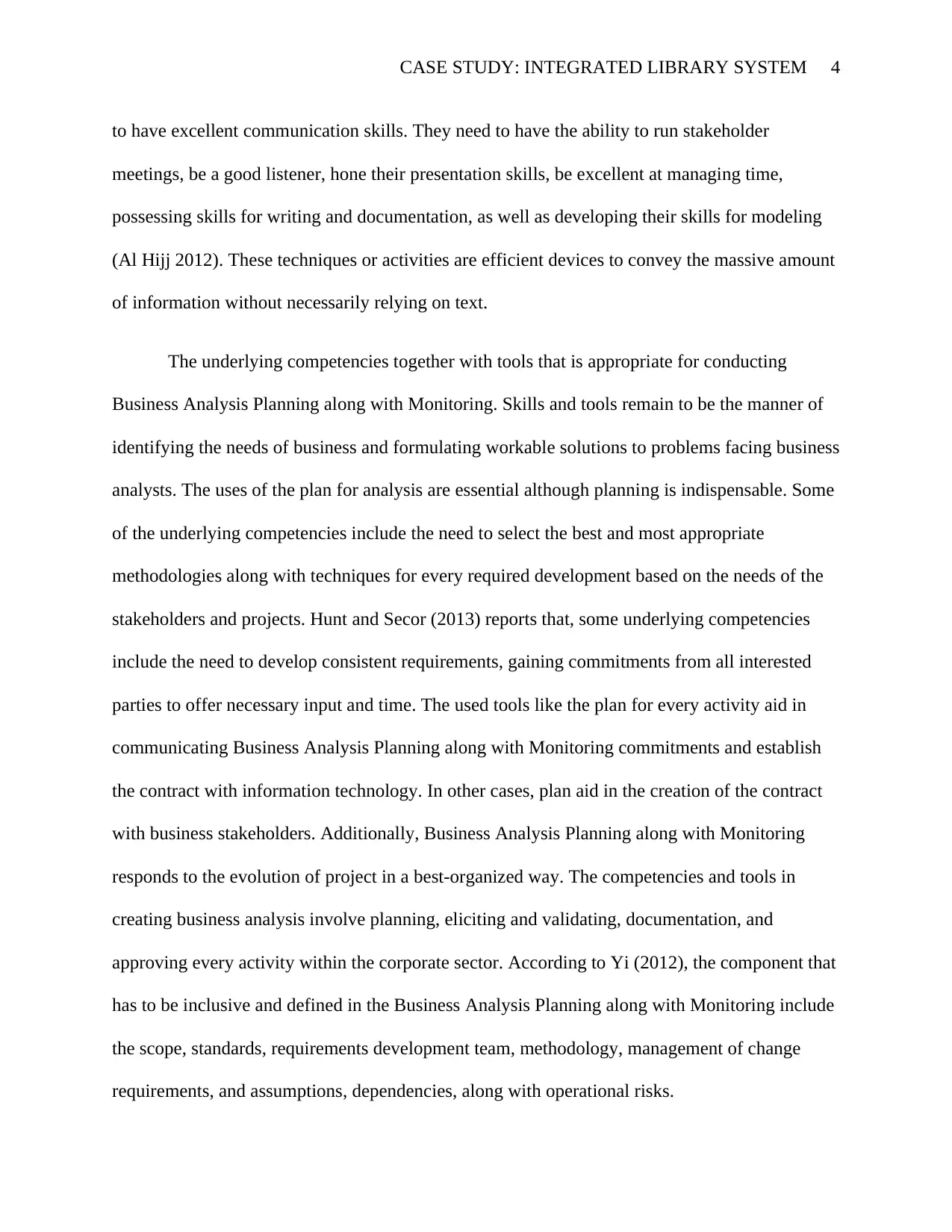
CASE STUDY: INTEGRATED LIBRARY SYSTEM 4
to have excellent communication skills. They need to have the ability to run stakeholder
meetings, be a good listener, hone their presentation skills, be excellent at managing time,
possessing skills for writing and documentation, as well as developing their skills for modeling
(Al Hijj 2012). These techniques or activities are efficient devices to convey the massive amount
of information without necessarily relying on text.
The underlying competencies together with tools that is appropriate for conducting
Business Analysis Planning along with Monitoring. Skills and tools remain to be the manner of
identifying the needs of business and formulating workable solutions to problems facing business
analysts. The uses of the plan for analysis are essential although planning is indispensable. Some
of the underlying competencies include the need to select the best and most appropriate
methodologies along with techniques for every required development based on the needs of the
stakeholders and projects. Hunt and Secor (2013) reports that, some underlying competencies
include the need to develop consistent requirements, gaining commitments from all interested
parties to offer necessary input and time. The used tools like the plan for every activity aid in
communicating Business Analysis Planning along with Monitoring commitments and establish
the contract with information technology. In other cases, plan aid in the creation of the contract
with business stakeholders. Additionally, Business Analysis Planning along with Monitoring
responds to the evolution of project in a best-organized way. The competencies and tools in
creating business analysis involve planning, eliciting and validating, documentation, and
approving every activity within the corporate sector. According to Yi (2012), the component that
has to be inclusive and defined in the Business Analysis Planning along with Monitoring include
the scope, standards, requirements development team, methodology, management of change
requirements, and assumptions, dependencies, along with operational risks.
to have excellent communication skills. They need to have the ability to run stakeholder
meetings, be a good listener, hone their presentation skills, be excellent at managing time,
possessing skills for writing and documentation, as well as developing their skills for modeling
(Al Hijj 2012). These techniques or activities are efficient devices to convey the massive amount
of information without necessarily relying on text.
The underlying competencies together with tools that is appropriate for conducting
Business Analysis Planning along with Monitoring. Skills and tools remain to be the manner of
identifying the needs of business and formulating workable solutions to problems facing business
analysts. The uses of the plan for analysis are essential although planning is indispensable. Some
of the underlying competencies include the need to select the best and most appropriate
methodologies along with techniques for every required development based on the needs of the
stakeholders and projects. Hunt and Secor (2013) reports that, some underlying competencies
include the need to develop consistent requirements, gaining commitments from all interested
parties to offer necessary input and time. The used tools like the plan for every activity aid in
communicating Business Analysis Planning along with Monitoring commitments and establish
the contract with information technology. In other cases, plan aid in the creation of the contract
with business stakeholders. Additionally, Business Analysis Planning along with Monitoring
responds to the evolution of project in a best-organized way. The competencies and tools in
creating business analysis involve planning, eliciting and validating, documentation, and
approving every activity within the corporate sector. According to Yi (2012), the component that
has to be inclusive and defined in the Business Analysis Planning along with Monitoring include
the scope, standards, requirements development team, methodology, management of change
requirements, and assumptions, dependencies, along with operational risks.
Paraphrase This Document
Need a fresh take? Get an instant paraphrase of this document with our AI Paraphraser
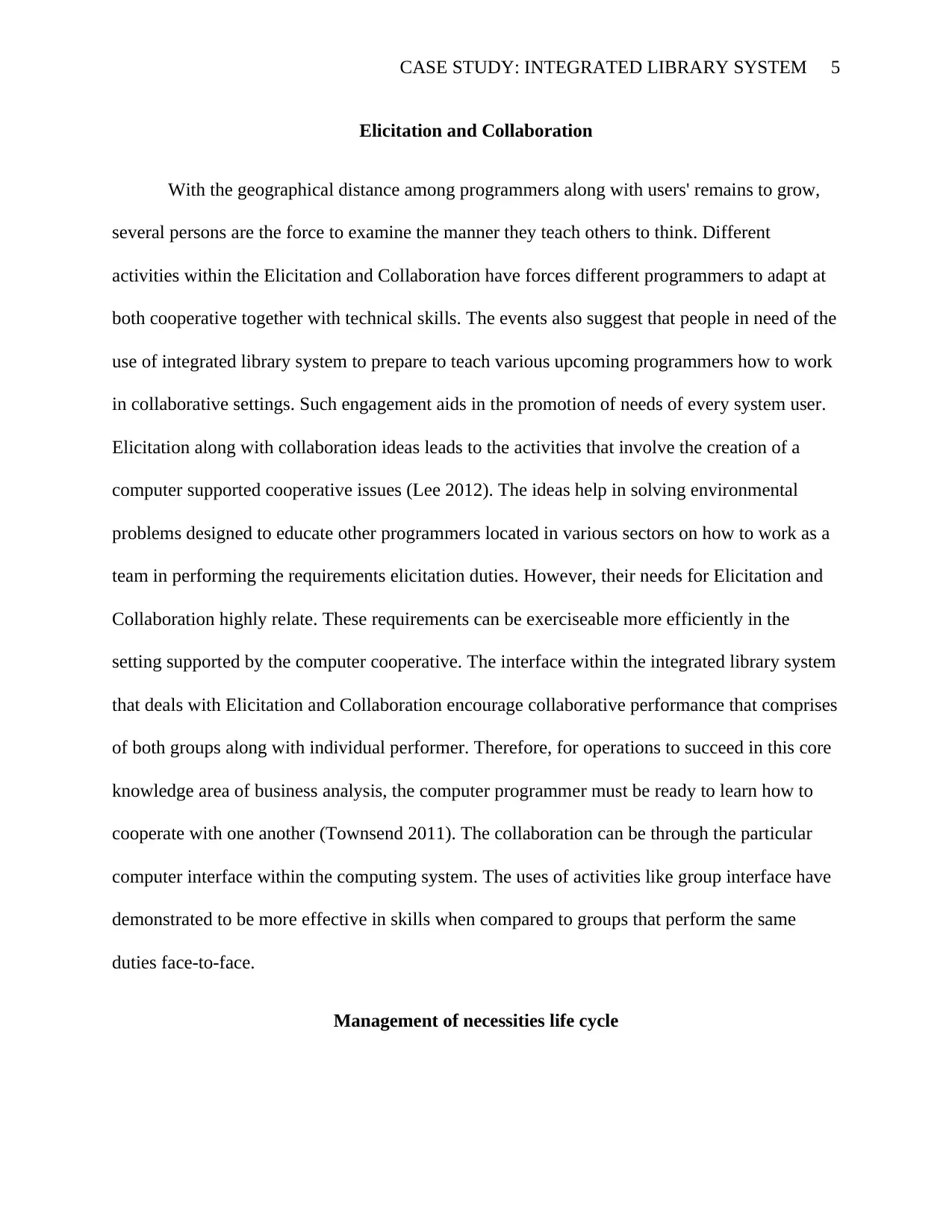
CASE STUDY: INTEGRATED LIBRARY SYSTEM 5
Elicitation and Collaboration
With the geographical distance among programmers along with users' remains to grow,
several persons are the force to examine the manner they teach others to think. Different
activities within the Elicitation and Collaboration have forces different programmers to adapt at
both cooperative together with technical skills. The events also suggest that people in need of the
use of integrated library system to prepare to teach various upcoming programmers how to work
in collaborative settings. Such engagement aids in the promotion of needs of every system user.
Elicitation along with collaboration ideas leads to the activities that involve the creation of a
computer supported cooperative issues (Lee 2012). The ideas help in solving environmental
problems designed to educate other programmers located in various sectors on how to work as a
team in performing the requirements elicitation duties. However, their needs for Elicitation and
Collaboration highly relate. These requirements can be exerciseable more efficiently in the
setting supported by the computer cooperative. The interface within the integrated library system
that deals with Elicitation and Collaboration encourage collaborative performance that comprises
of both groups along with individual performer. Therefore, for operations to succeed in this core
knowledge area of business analysis, the computer programmer must be ready to learn how to
cooperate with one another (Townsend 2011). The collaboration can be through the particular
computer interface within the computing system. The uses of activities like group interface have
demonstrated to be more effective in skills when compared to groups that perform the same
duties face-to-face.
Management of necessities life cycle
Elicitation and Collaboration
With the geographical distance among programmers along with users' remains to grow,
several persons are the force to examine the manner they teach others to think. Different
activities within the Elicitation and Collaboration have forces different programmers to adapt at
both cooperative together with technical skills. The events also suggest that people in need of the
use of integrated library system to prepare to teach various upcoming programmers how to work
in collaborative settings. Such engagement aids in the promotion of needs of every system user.
Elicitation along with collaboration ideas leads to the activities that involve the creation of a
computer supported cooperative issues (Lee 2012). The ideas help in solving environmental
problems designed to educate other programmers located in various sectors on how to work as a
team in performing the requirements elicitation duties. However, their needs for Elicitation and
Collaboration highly relate. These requirements can be exerciseable more efficiently in the
setting supported by the computer cooperative. The interface within the integrated library system
that deals with Elicitation and Collaboration encourage collaborative performance that comprises
of both groups along with individual performer. Therefore, for operations to succeed in this core
knowledge area of business analysis, the computer programmer must be ready to learn how to
cooperate with one another (Townsend 2011). The collaboration can be through the particular
computer interface within the computing system. The uses of activities like group interface have
demonstrated to be more effective in skills when compared to groups that perform the same
duties face-to-face.
Management of necessities life cycle
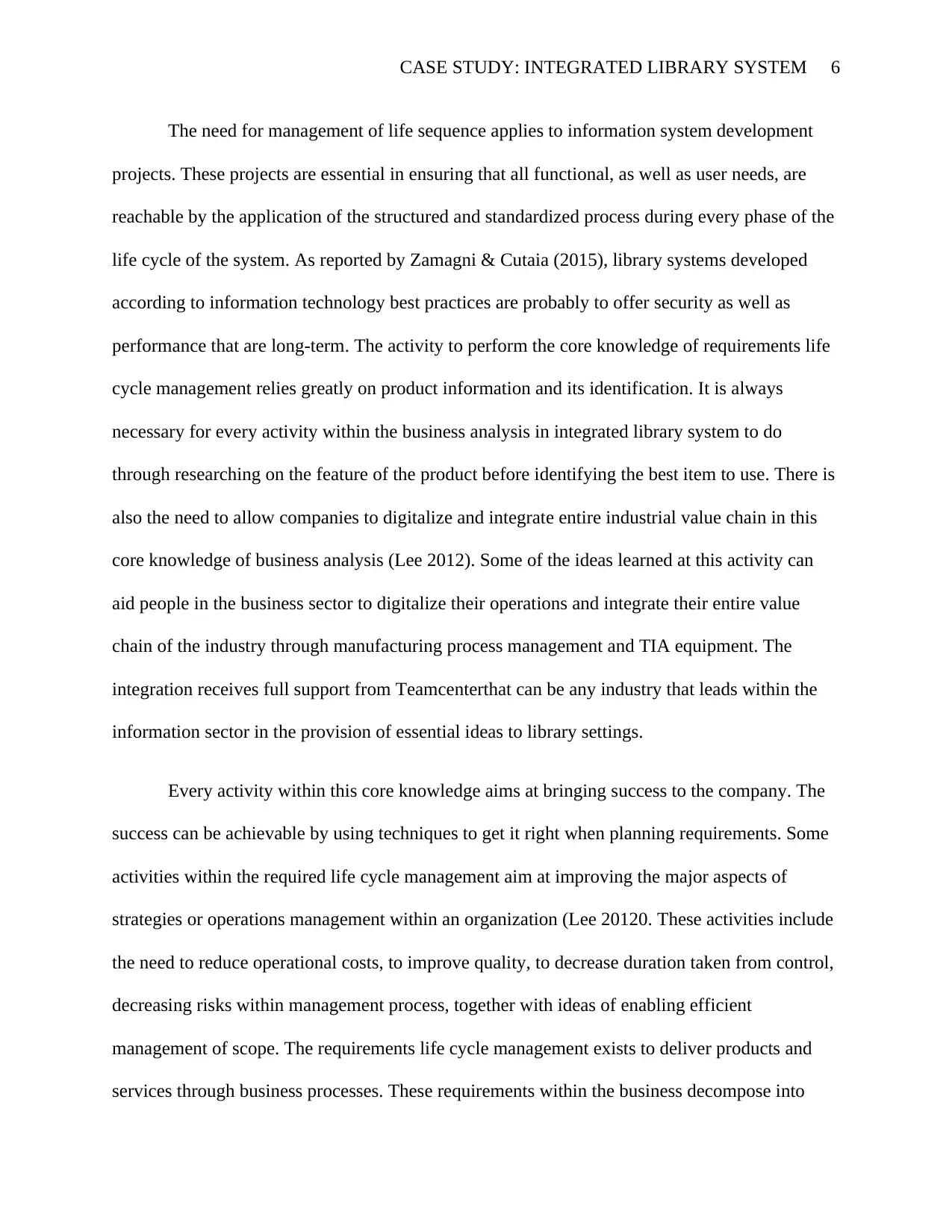
CASE STUDY: INTEGRATED LIBRARY SYSTEM 6
The need for management of life sequence applies to information system development
projects. These projects are essential in ensuring that all functional, as well as user needs, are
reachable by the application of the structured and standardized process during every phase of the
life cycle of the system. As reported by Zamagni & Cutaia (2015), library systems developed
according to information technology best practices are probably to offer security as well as
performance that are long-term. The activity to perform the core knowledge of requirements life
cycle management relies greatly on product information and its identification. It is always
necessary for every activity within the business analysis in integrated library system to do
through researching on the feature of the product before identifying the best item to use. There is
also the need to allow companies to digitalize and integrate entire industrial value chain in this
core knowledge of business analysis (Lee 2012). Some of the ideas learned at this activity can
aid people in the business sector to digitalize their operations and integrate their entire value
chain of the industry through manufacturing process management and TIA equipment. The
integration receives full support from Teamcenterthat can be any industry that leads within the
information sector in the provision of essential ideas to library settings.
Every activity within this core knowledge aims at bringing success to the company. The
success can be achievable by using techniques to get it right when planning requirements. Some
activities within the required life cycle management aim at improving the major aspects of
strategies or operations management within an organization (Lee 20120. These activities include
the need to reduce operational costs, to improve quality, to decrease duration taken from control,
decreasing risks within management process, together with ideas of enabling efficient
management of scope. The requirements life cycle management exists to deliver products and
services through business processes. These requirements within the business decompose into
The need for management of life sequence applies to information system development
projects. These projects are essential in ensuring that all functional, as well as user needs, are
reachable by the application of the structured and standardized process during every phase of the
life cycle of the system. As reported by Zamagni & Cutaia (2015), library systems developed
according to information technology best practices are probably to offer security as well as
performance that are long-term. The activity to perform the core knowledge of requirements life
cycle management relies greatly on product information and its identification. It is always
necessary for every activity within the business analysis in integrated library system to do
through researching on the feature of the product before identifying the best item to use. There is
also the need to allow companies to digitalize and integrate entire industrial value chain in this
core knowledge of business analysis (Lee 2012). Some of the ideas learned at this activity can
aid people in the business sector to digitalize their operations and integrate their entire value
chain of the industry through manufacturing process management and TIA equipment. The
integration receives full support from Teamcenterthat can be any industry that leads within the
information sector in the provision of essential ideas to library settings.
Every activity within this core knowledge aims at bringing success to the company. The
success can be achievable by using techniques to get it right when planning requirements. Some
activities within the required life cycle management aim at improving the major aspects of
strategies or operations management within an organization (Lee 20120. These activities include
the need to reduce operational costs, to improve quality, to decrease duration taken from control,
decreasing risks within management process, together with ideas of enabling efficient
management of scope. The requirements life cycle management exists to deliver products and
services through business processes. These requirements within the business decompose into
⊘ This is a preview!⊘
Do you want full access?
Subscribe today to unlock all pages.

Trusted by 1+ million students worldwide
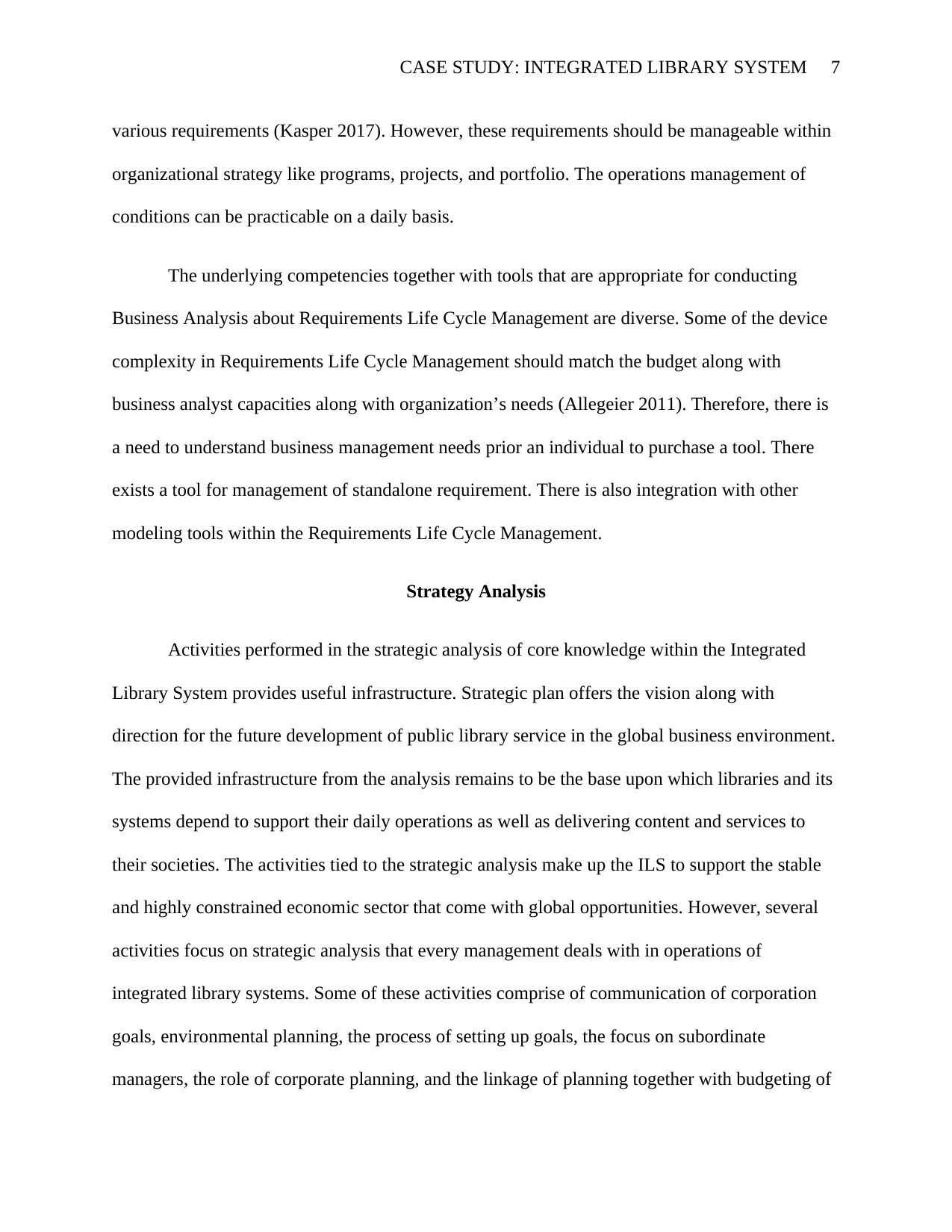
CASE STUDY: INTEGRATED LIBRARY SYSTEM 7
various requirements (Kasper 2017). However, these requirements should be manageable within
organizational strategy like programs, projects, and portfolio. The operations management of
conditions can be practicable on a daily basis.
The underlying competencies together with tools that are appropriate for conducting
Business Analysis about Requirements Life Cycle Management are diverse. Some of the device
complexity in Requirements Life Cycle Management should match the budget along with
business analyst capacities along with organization’s needs (Allegeier 2011). Therefore, there is
a need to understand business management needs prior an individual to purchase a tool. There
exists a tool for management of standalone requirement. There is also integration with other
modeling tools within the Requirements Life Cycle Management.
Strategy Analysis
Activities performed in the strategic analysis of core knowledge within the Integrated
Library System provides useful infrastructure. Strategic plan offers the vision along with
direction for the future development of public library service in the global business environment.
The provided infrastructure from the analysis remains to be the base upon which libraries and its
systems depend to support their daily operations as well as delivering content and services to
their societies. The activities tied to the strategic analysis make up the ILS to support the stable
and highly constrained economic sector that come with global opportunities. However, several
activities focus on strategic analysis that every management deals with in operations of
integrated library systems. Some of these activities comprise of communication of corporation
goals, environmental planning, the process of setting up goals, the focus on subordinate
managers, the role of corporate planning, and the linkage of planning together with budgeting of
various requirements (Kasper 2017). However, these requirements should be manageable within
organizational strategy like programs, projects, and portfolio. The operations management of
conditions can be practicable on a daily basis.
The underlying competencies together with tools that are appropriate for conducting
Business Analysis about Requirements Life Cycle Management are diverse. Some of the device
complexity in Requirements Life Cycle Management should match the budget along with
business analyst capacities along with organization’s needs (Allegeier 2011). Therefore, there is
a need to understand business management needs prior an individual to purchase a tool. There
exists a tool for management of standalone requirement. There is also integration with other
modeling tools within the Requirements Life Cycle Management.
Strategy Analysis
Activities performed in the strategic analysis of core knowledge within the Integrated
Library System provides useful infrastructure. Strategic plan offers the vision along with
direction for the future development of public library service in the global business environment.
The provided infrastructure from the analysis remains to be the base upon which libraries and its
systems depend to support their daily operations as well as delivering content and services to
their societies. The activities tied to the strategic analysis make up the ILS to support the stable
and highly constrained economic sector that come with global opportunities. However, several
activities focus on strategic analysis that every management deals with in operations of
integrated library systems. Some of these activities comprise of communication of corporation
goals, environmental planning, the process of setting up goals, the focus on subordinate
managers, the role of corporate planning, and the linkage of planning together with budgeting of
Paraphrase This Document
Need a fresh take? Get an instant paraphrase of this document with our AI Paraphraser
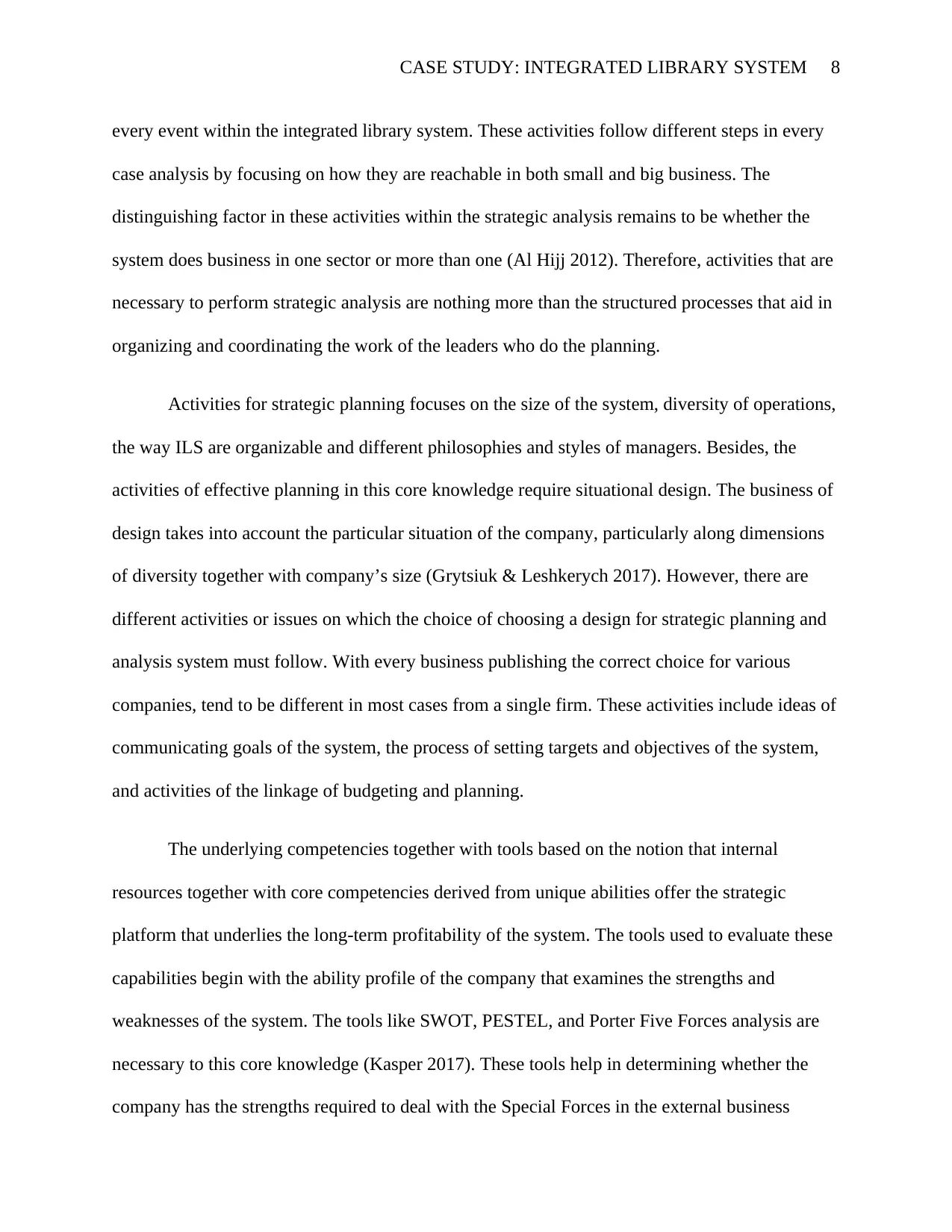
CASE STUDY: INTEGRATED LIBRARY SYSTEM 8
every event within the integrated library system. These activities follow different steps in every
case analysis by focusing on how they are reachable in both small and big business. The
distinguishing factor in these activities within the strategic analysis remains to be whether the
system does business in one sector or more than one (Al Hijj 2012). Therefore, activities that are
necessary to perform strategic analysis are nothing more than the structured processes that aid in
organizing and coordinating the work of the leaders who do the planning.
Activities for strategic planning focuses on the size of the system, diversity of operations,
the way ILS are organizable and different philosophies and styles of managers. Besides, the
activities of effective planning in this core knowledge require situational design. The business of
design takes into account the particular situation of the company, particularly along dimensions
of diversity together with company’s size (Grytsiuk & Leshkerych 2017). However, there are
different activities or issues on which the choice of choosing a design for strategic planning and
analysis system must follow. With every business publishing the correct choice for various
companies, tend to be different in most cases from a single firm. These activities include ideas of
communicating goals of the system, the process of setting targets and objectives of the system,
and activities of the linkage of budgeting and planning.
The underlying competencies together with tools based on the notion that internal
resources together with core competencies derived from unique abilities offer the strategic
platform that underlies the long-term profitability of the system. The tools used to evaluate these
capabilities begin with the ability profile of the company that examines the strengths and
weaknesses of the system. The tools like SWOT, PESTEL, and Porter Five Forces analysis are
necessary to this core knowledge (Kasper 2017). These tools help in determining whether the
company has the strengths required to deal with the Special Forces in the external business
every event within the integrated library system. These activities follow different steps in every
case analysis by focusing on how they are reachable in both small and big business. The
distinguishing factor in these activities within the strategic analysis remains to be whether the
system does business in one sector or more than one (Al Hijj 2012). Therefore, activities that are
necessary to perform strategic analysis are nothing more than the structured processes that aid in
organizing and coordinating the work of the leaders who do the planning.
Activities for strategic planning focuses on the size of the system, diversity of operations,
the way ILS are organizable and different philosophies and styles of managers. Besides, the
activities of effective planning in this core knowledge require situational design. The business of
design takes into account the particular situation of the company, particularly along dimensions
of diversity together with company’s size (Grytsiuk & Leshkerych 2017). However, there are
different activities or issues on which the choice of choosing a design for strategic planning and
analysis system must follow. With every business publishing the correct choice for various
companies, tend to be different in most cases from a single firm. These activities include ideas of
communicating goals of the system, the process of setting targets and objectives of the system,
and activities of the linkage of budgeting and planning.
The underlying competencies together with tools based on the notion that internal
resources together with core competencies derived from unique abilities offer the strategic
platform that underlies the long-term profitability of the system. The tools used to evaluate these
capabilities begin with the ability profile of the company that examines the strengths and
weaknesses of the system. The tools like SWOT, PESTEL, and Porter Five Forces analysis are
necessary to this core knowledge (Kasper 2017). These tools help in determining whether the
company has the strengths required to deal with the Special Forces in the external business
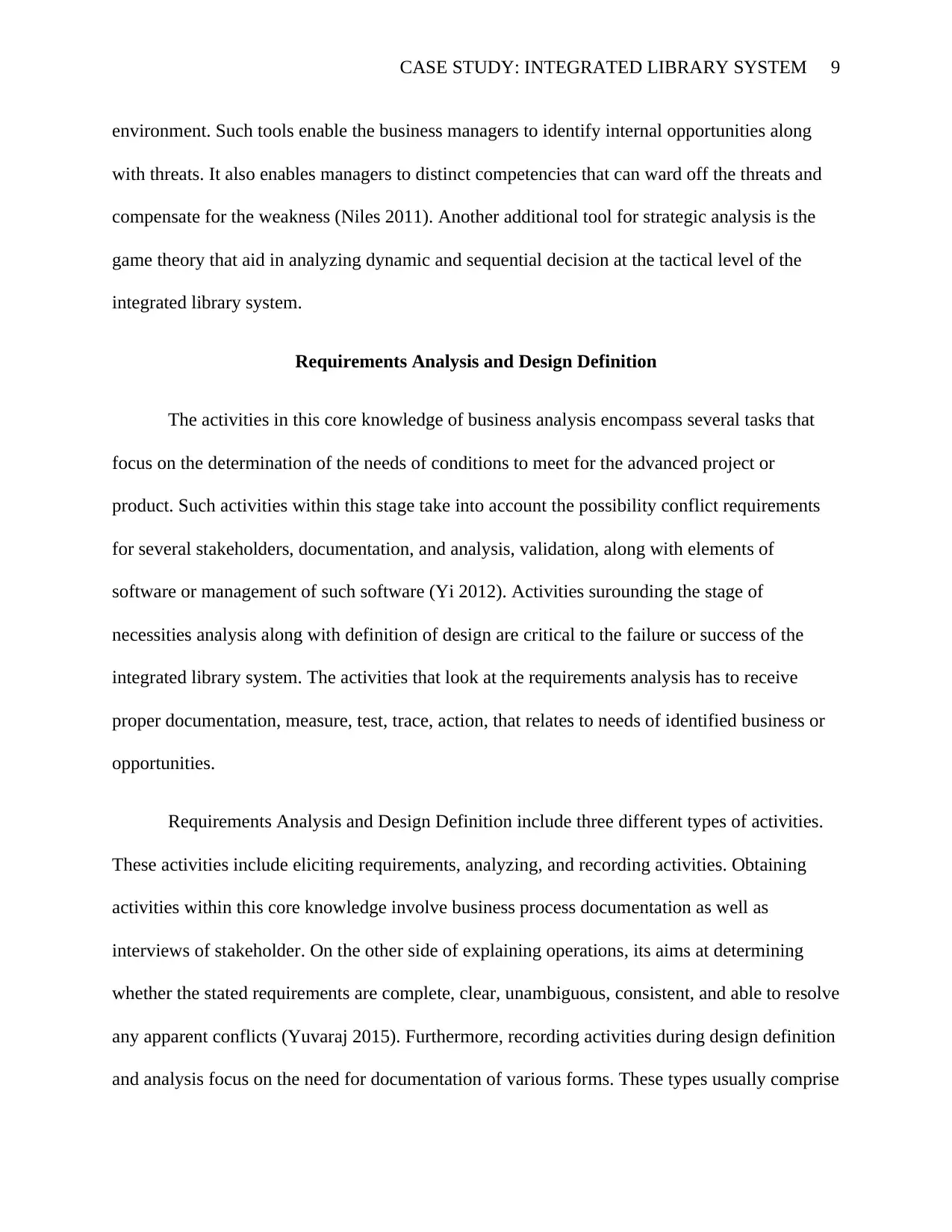
CASE STUDY: INTEGRATED LIBRARY SYSTEM 9
environment. Such tools enable the business managers to identify internal opportunities along
with threats. It also enables managers to distinct competencies that can ward off the threats and
compensate for the weakness (Niles 2011). Another additional tool for strategic analysis is the
game theory that aid in analyzing dynamic and sequential decision at the tactical level of the
integrated library system.
Requirements Analysis and Design Definition
The activities in this core knowledge of business analysis encompass several tasks that
focus on the determination of the needs of conditions to meet for the advanced project or
product. Such activities within this stage take into account the possibility conflict requirements
for several stakeholders, documentation, and analysis, validation, along with elements of
software or management of such software (Yi 2012). Activities surounding the stage of
necessities analysis along with definition of design are critical to the failure or success of the
integrated library system. The activities that look at the requirements analysis has to receive
proper documentation, measure, test, trace, action, that relates to needs of identified business or
opportunities.
Requirements Analysis and Design Definition include three different types of activities.
These activities include eliciting requirements, analyzing, and recording activities. Obtaining
activities within this core knowledge involve business process documentation as well as
interviews of stakeholder. On the other side of explaining operations, its aims at determining
whether the stated requirements are complete, clear, unambiguous, consistent, and able to resolve
any apparent conflicts (Yuvaraj 2015). Furthermore, recording activities during design definition
and analysis focus on the need for documentation of various forms. These types usually comprise
environment. Such tools enable the business managers to identify internal opportunities along
with threats. It also enables managers to distinct competencies that can ward off the threats and
compensate for the weakness (Niles 2011). Another additional tool for strategic analysis is the
game theory that aid in analyzing dynamic and sequential decision at the tactical level of the
integrated library system.
Requirements Analysis and Design Definition
The activities in this core knowledge of business analysis encompass several tasks that
focus on the determination of the needs of conditions to meet for the advanced project or
product. Such activities within this stage take into account the possibility conflict requirements
for several stakeholders, documentation, and analysis, validation, along with elements of
software or management of such software (Yi 2012). Activities surounding the stage of
necessities analysis along with definition of design are critical to the failure or success of the
integrated library system. The activities that look at the requirements analysis has to receive
proper documentation, measure, test, trace, action, that relates to needs of identified business or
opportunities.
Requirements Analysis and Design Definition include three different types of activities.
These activities include eliciting requirements, analyzing, and recording activities. Obtaining
activities within this core knowledge involve business process documentation as well as
interviews of stakeholder. On the other side of explaining operations, its aims at determining
whether the stated requirements are complete, clear, unambiguous, consistent, and able to resolve
any apparent conflicts (Yuvaraj 2015). Furthermore, recording activities during design definition
and analysis focus on the need for documentation of various forms. These types usually comprise
⊘ This is a preview!⊘
Do you want full access?
Subscribe today to unlock all pages.

Trusted by 1+ million students worldwide
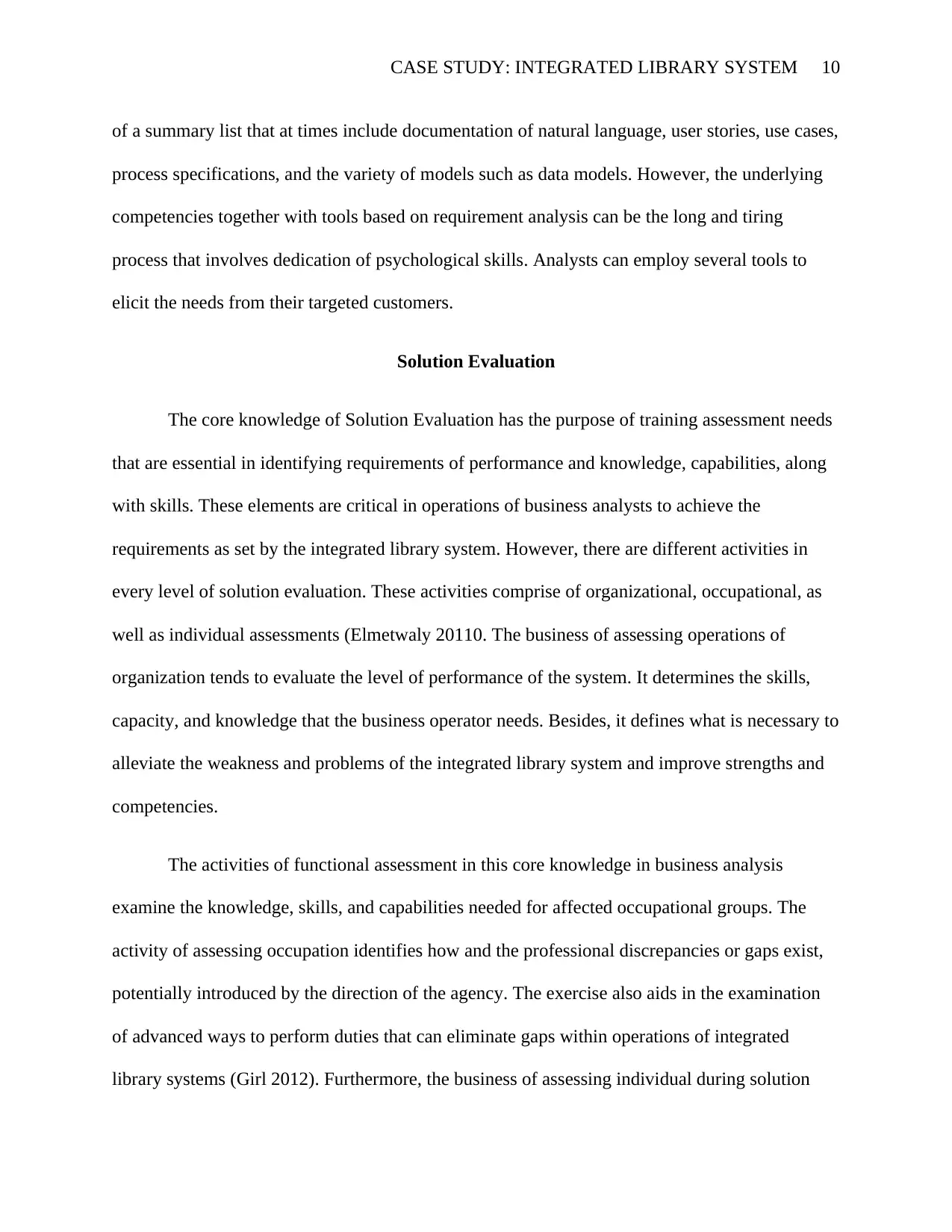
CASE STUDY: INTEGRATED LIBRARY SYSTEM 10
of a summary list that at times include documentation of natural language, user stories, use cases,
process specifications, and the variety of models such as data models. However, the underlying
competencies together with tools based on requirement analysis can be the long and tiring
process that involves dedication of psychological skills. Analysts can employ several tools to
elicit the needs from their targeted customers.
Solution Evaluation
The core knowledge of Solution Evaluation has the purpose of training assessment needs
that are essential in identifying requirements of performance and knowledge, capabilities, along
with skills. These elements are critical in operations of business analysts to achieve the
requirements as set by the integrated library system. However, there are different activities in
every level of solution evaluation. These activities comprise of organizational, occupational, as
well as individual assessments (Elmetwaly 20110. The business of assessing operations of
organization tends to evaluate the level of performance of the system. It determines the skills,
capacity, and knowledge that the business operator needs. Besides, it defines what is necessary to
alleviate the weakness and problems of the integrated library system and improve strengths and
competencies.
The activities of functional assessment in this core knowledge in business analysis
examine the knowledge, skills, and capabilities needed for affected occupational groups. The
activity of assessing occupation identifies how and the professional discrepancies or gaps exist,
potentially introduced by the direction of the agency. The exercise also aids in the examination
of advanced ways to perform duties that can eliminate gaps within operations of integrated
library systems (Girl 2012). Furthermore, the business of assessing individual during solution
of a summary list that at times include documentation of natural language, user stories, use cases,
process specifications, and the variety of models such as data models. However, the underlying
competencies together with tools based on requirement analysis can be the long and tiring
process that involves dedication of psychological skills. Analysts can employ several tools to
elicit the needs from their targeted customers.
Solution Evaluation
The core knowledge of Solution Evaluation has the purpose of training assessment needs
that are essential in identifying requirements of performance and knowledge, capabilities, along
with skills. These elements are critical in operations of business analysts to achieve the
requirements as set by the integrated library system. However, there are different activities in
every level of solution evaluation. These activities comprise of organizational, occupational, as
well as individual assessments (Elmetwaly 20110. The business of assessing operations of
organization tends to evaluate the level of performance of the system. It determines the skills,
capacity, and knowledge that the business operator needs. Besides, it defines what is necessary to
alleviate the weakness and problems of the integrated library system and improve strengths and
competencies.
The activities of functional assessment in this core knowledge in business analysis
examine the knowledge, skills, and capabilities needed for affected occupational groups. The
activity of assessing occupation identifies how and the professional discrepancies or gaps exist,
potentially introduced by the direction of the agency. The exercise also aids in the examination
of advanced ways to perform duties that can eliminate gaps within operations of integrated
library systems (Girl 2012). Furthermore, the business of assessing individual during solution
Paraphrase This Document
Need a fresh take? Get an instant paraphrase of this document with our AI Paraphraser
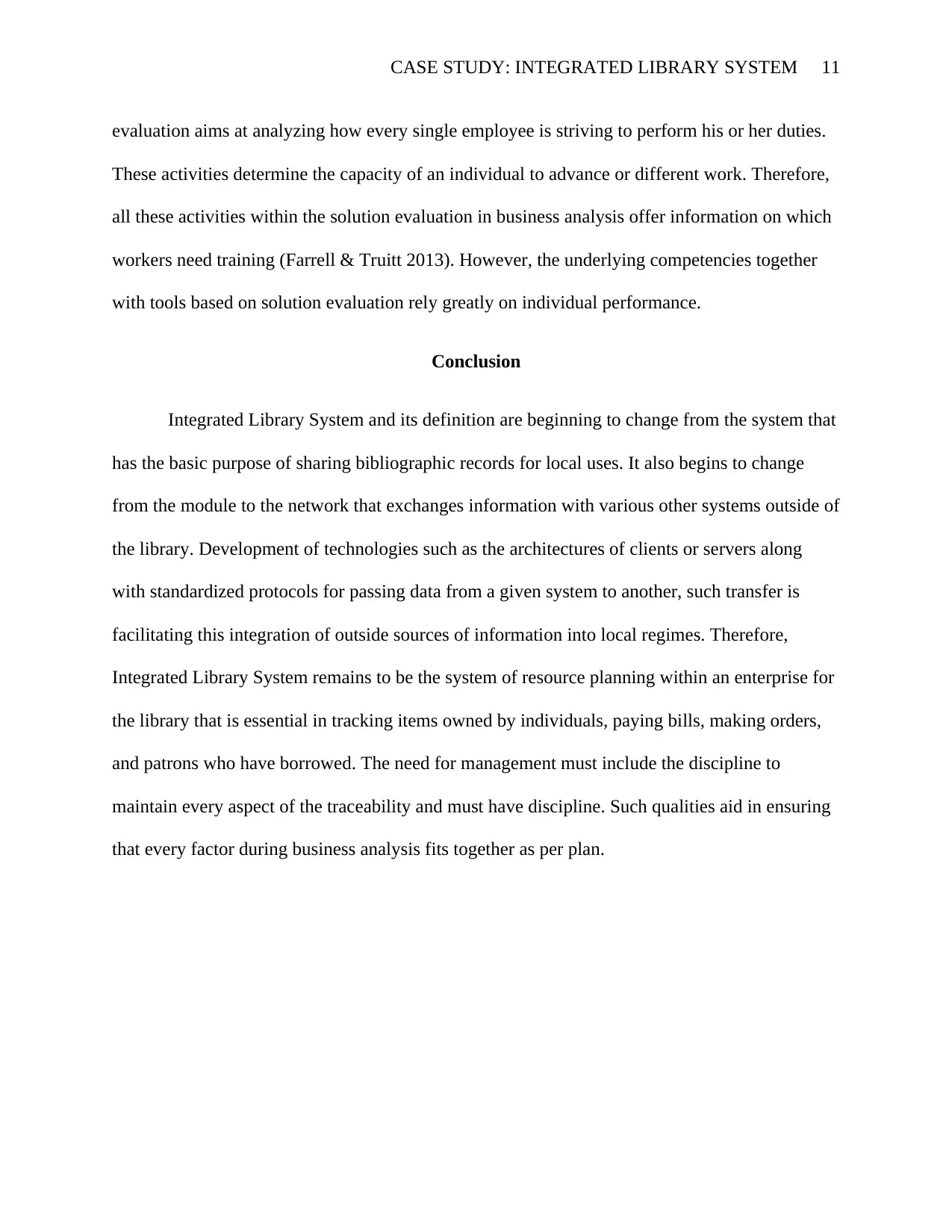
CASE STUDY: INTEGRATED LIBRARY SYSTEM 11
evaluation aims at analyzing how every single employee is striving to perform his or her duties.
These activities determine the capacity of an individual to advance or different work. Therefore,
all these activities within the solution evaluation in business analysis offer information on which
workers need training (Farrell & Truitt 2013). However, the underlying competencies together
with tools based on solution evaluation rely greatly on individual performance.
Conclusion
Integrated Library System and its definition are beginning to change from the system that
has the basic purpose of sharing bibliographic records for local uses. It also begins to change
from the module to the network that exchanges information with various other systems outside of
the library. Development of technologies such as the architectures of clients or servers along
with standardized protocols for passing data from a given system to another, such transfer is
facilitating this integration of outside sources of information into local regimes. Therefore,
Integrated Library System remains to be the system of resource planning within an enterprise for
the library that is essential in tracking items owned by individuals, paying bills, making orders,
and patrons who have borrowed. The need for management must include the discipline to
maintain every aspect of the traceability and must have discipline. Such qualities aid in ensuring
that every factor during business analysis fits together as per plan.
evaluation aims at analyzing how every single employee is striving to perform his or her duties.
These activities determine the capacity of an individual to advance or different work. Therefore,
all these activities within the solution evaluation in business analysis offer information on which
workers need training (Farrell & Truitt 2013). However, the underlying competencies together
with tools based on solution evaluation rely greatly on individual performance.
Conclusion
Integrated Library System and its definition are beginning to change from the system that
has the basic purpose of sharing bibliographic records for local uses. It also begins to change
from the module to the network that exchanges information with various other systems outside of
the library. Development of technologies such as the architectures of clients or servers along
with standardized protocols for passing data from a given system to another, such transfer is
facilitating this integration of outside sources of information into local regimes. Therefore,
Integrated Library System remains to be the system of resource planning within an enterprise for
the library that is essential in tracking items owned by individuals, paying bills, making orders,
and patrons who have borrowed. The need for management must include the discipline to
maintain every aspect of the traceability and must have discipline. Such qualities aid in ensuring
that every factor during business analysis fits together as per plan.
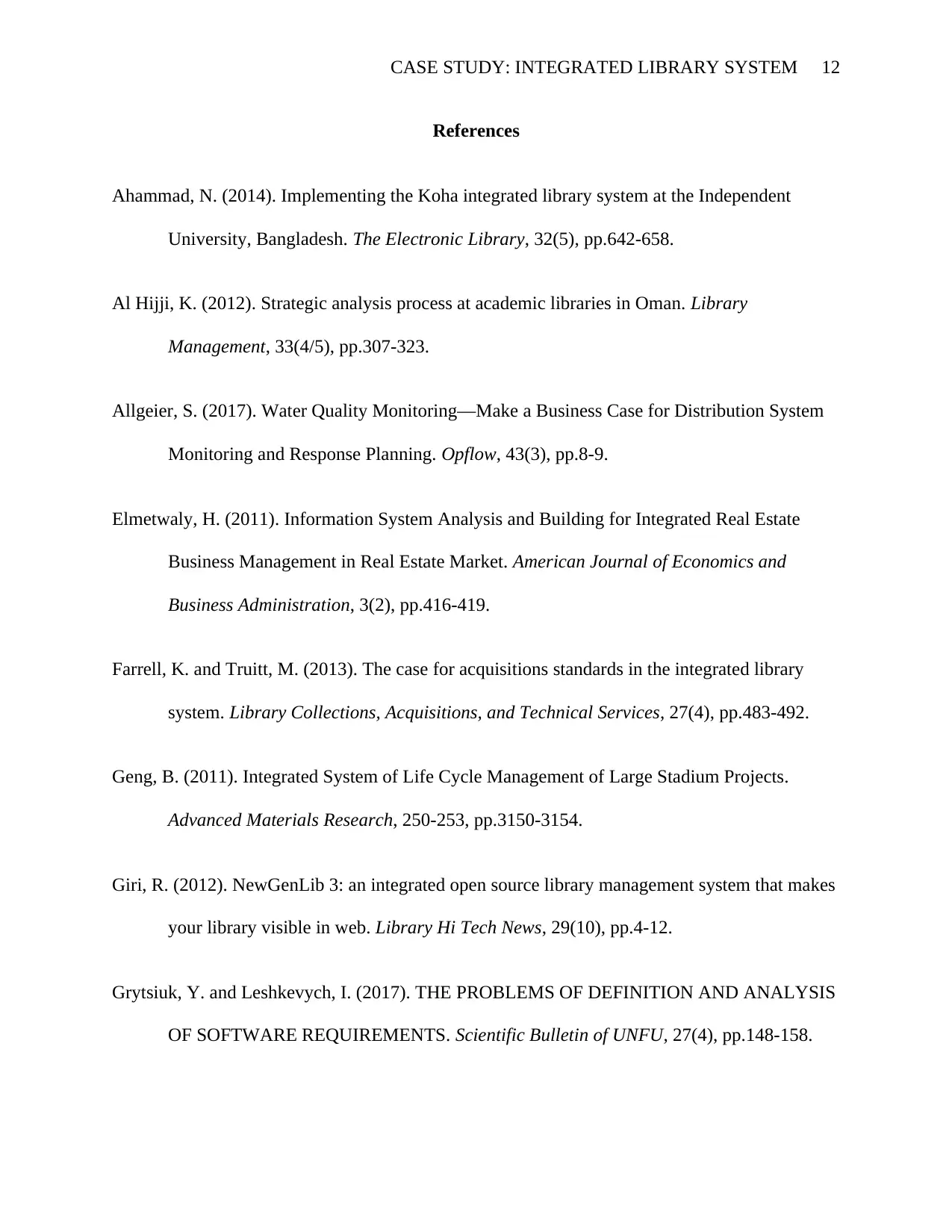
CASE STUDY: INTEGRATED LIBRARY SYSTEM 12
References
Ahammad, N. (2014). Implementing the Koha integrated library system at the Independent
University, Bangladesh. The Electronic Library, 32(5), pp.642-658.
Al Hijji, K. (2012). Strategic analysis process at academic libraries in Oman. Library
Management, 33(4/5), pp.307-323.
Allgeier, S. (2017). Water Quality Monitoring—Make a Business Case for Distribution System
Monitoring and Response Planning. Opflow, 43(3), pp.8-9.
Elmetwaly, H. (2011). Information System Analysis and Building for Integrated Real Estate
Business Management in Real Estate Market. American Journal of Economics and
Business Administration, 3(2), pp.416-419.
Farrell, K. and Truitt, M. (2013). The case for acquisitions standards in the integrated library
system. Library Collections, Acquisitions, and Technical Services, 27(4), pp.483-492.
Geng, B. (2011). Integrated System of Life Cycle Management of Large Stadium Projects.
Advanced Materials Research, 250-253, pp.3150-3154.
Giri, R. (2012). NewGenLib 3: an integrated open source library management system that makes
your library visible in web. Library Hi Tech News, 29(10), pp.4-12.
Grytsiuk, Y. and Leshkevych, I. (2017). THE PROBLEMS OF DEFINITION AND ANALYSIS
OF SOFTWARE REQUIREMENTS. Scientific Bulletin of UNFU, 27(4), pp.148-158.
References
Ahammad, N. (2014). Implementing the Koha integrated library system at the Independent
University, Bangladesh. The Electronic Library, 32(5), pp.642-658.
Al Hijji, K. (2012). Strategic analysis process at academic libraries in Oman. Library
Management, 33(4/5), pp.307-323.
Allgeier, S. (2017). Water Quality Monitoring—Make a Business Case for Distribution System
Monitoring and Response Planning. Opflow, 43(3), pp.8-9.
Elmetwaly, H. (2011). Information System Analysis and Building for Integrated Real Estate
Business Management in Real Estate Market. American Journal of Economics and
Business Administration, 3(2), pp.416-419.
Farrell, K. and Truitt, M. (2013). The case for acquisitions standards in the integrated library
system. Library Collections, Acquisitions, and Technical Services, 27(4), pp.483-492.
Geng, B. (2011). Integrated System of Life Cycle Management of Large Stadium Projects.
Advanced Materials Research, 250-253, pp.3150-3154.
Giri, R. (2012). NewGenLib 3: an integrated open source library management system that makes
your library visible in web. Library Hi Tech News, 29(10), pp.4-12.
Grytsiuk, Y. and Leshkevych, I. (2017). THE PROBLEMS OF DEFINITION AND ANALYSIS
OF SOFTWARE REQUIREMENTS. Scientific Bulletin of UNFU, 27(4), pp.148-158.
⊘ This is a preview!⊘
Do you want full access?
Subscribe today to unlock all pages.

Trusted by 1+ million students worldwide
1 out of 14
Related Documents
Your All-in-One AI-Powered Toolkit for Academic Success.
+13062052269
info@desklib.com
Available 24*7 on WhatsApp / Email
![[object Object]](/_next/static/media/star-bottom.7253800d.svg)
Unlock your academic potential
Copyright © 2020–2025 A2Z Services. All Rights Reserved. Developed and managed by ZUCOL.





